“It is our architecture today: great screens on which are reflected atoms, particles, molecules in motion. Not a public scene or true public space but gigantic spaces of circulation, ventilation and ephemeral connections”1
It is at intersections which development first springs up, where we are already stopped and most likely to be distracted from our end destination. The first gas station is at 231 and 10. Fast food, gas stations, and other businesses crop up at Demotte, another intersection of 231 and 10, as well as the intersection of many residential streets. It is here that objects begin their competition to survive within the void. It is where circulation is the strongest that the object begins its competition against the flow, attempting to subvert, to distract, to slide a destination in between a destination. (But these aren?t really destinations, more like pitstops.) You can drive around the object so that you won?t feel like you actually stopped on your way to the goal. The object needs the final destination, as it needs the journey, but it also needs to stop (or maybe pause) the pursuit of the destination, to pull circulation out and into it, to get someone out of the current so they can shop and buy. And here at the beginning, the object attempts to make itself bigger through communication, shock, and contrast. Large signs, painted buildings, completely different styles of ornamental architectural bait attempt to catch the eye of said consumer and reel them out of the current. Catch and release. Because it is quantity, quantity, quantity at this level.
Merrillville is much the same as Demotte. Development is centered around the intersection of US30 and I65. The objects attempt to attract the consumer. The parking lot is one of the greater attractions here: a visible promise of being able to get off of the path and back on quickly. Thus each object has its own and flaunts it proudly by putting it in front of the building.
The space builds up rhythmically, with lines of corn stubble and trees, fence posts, barns, silos, telephone poles, houses, gas stations, mobile home parks, rail road tracks, bridges, highway ramps, warehouses, power towers, factories, cellular towers, mini-malls, fast-food chains, apartment complexes, subdivisions, office towers, elevated rail road tracks, high rises, elevated trains, fire stairs, and skyscrapers. We do not encounter these objects and ask what they mean. We experience these as a flow of space and rhythm, as a series of objects within a space. We experience the space between, the difference between the objects. The most imposing, the most compelling spaces are those not built by the modern culture, those undefined, those which were left between, rests separating the beats, silence dividing the tones, the seeping void inhabited while inside the outside. It was the disregard for the void, the perceived impenetrability, the necessity of simplicity, which created the complex relations that exists between objects. By excluding the complexity of this exterior space while designing the object, the complexity was produced. Layer upon layer was built, with each layer requiring its own tearing down, building up, customization. There is no outside referral. There is only gratification, only objectification.2
In Gary we begin to feel the magnetism of the powerful object-void dichotomy which is Chicago. Here are forced those elements which are necessary to the Loop, but which are not allowed to exit in the Loop. It is an industrial strip mine for the needs of the larger urban. These are land mongers. The various towers and services, such as power, the L, telephone coming out of the city here align themselves along the major circulation route.3
“We are no longer a part of the drama of alienation; we live in the ecstasy of communication. And this ecstasy is obscene?.today there is a whole pornography of information and communication, that is to say, of circuits and networks, a pornography of all functions and objects in their readability, their fluidity, their availability, their regulation, in their forced signification, in their performativity, in their branching, in their polyvalence, in their free expression?”4
At the Indiana Toll Road, the Skyway, you must stop at the toll booth to pay for the circulation route over and above, uninhibited by those objects below. At the top of the skyway, at the apex, you can see, far in the distance the magnetic center. This is a circulation space which flows so quickly and freely that no object can attract the consumer out of the current. This circulation has too much purpose for distractions. We are projected miles into the future, our immediate surroundings do not matter any longer because we are already past them. We through industry and residential which also relate only to that which is far off, the center. These places are served by the road in that they may get on it and go to the center, but any thoughts of distracting from the magnetism of the center at this point is unimaginable. These places benefit from servicing the center, rather than servicing circulation. It is no longer a matter of distractions, it is a matter of destinations.
The Dan Ryan is a trench dug through. It does not even exist in the same realm as the buildings on either side. The new Comiskey Park and Taylor Homes stand in silence along the loud rush. We have been pulled along by the magnetic dichotomy that came into site on the skyway. The tallest and most evolved around which the rest radiates. As we pull off the Dan Ryan and onto the Eisenhower, we enter the immediate realm of the Loop. Here the Chicago stock exchange stretches across to greet the slowing onslaught of circulation.
Within minutes we are at a stand still on Michigan Ave. The river dumps into Lake Michigan. The current dumps into the Deep. Here, in the center of destination, the object and void fill the spaces allotted to each. The line of building and circulation is drawn and extended infinitely upward. Here the war is filled to its very edges.
“It is the very figure of producing, of leading-beyond, of continuous and undefinable overcoming” of object over another object which defines the architecture of nihilism, which defines the metropolis, which defines the void.5 The evolution of the object to its stronger, more pure state is a result of the harsh environment of conflict and competition within the city. It is the dichotomy of object and void that produces the rhythms, the contradictions, the competition, the evolution of urban.
“These monsters? engender others to infinity, ?battle it out within a space rendered dramatic by their very competition?. It is in such a space that the pure architectural object is born, an object beyond the control of architects, which roundly repudiates the city and its uses, repudiates the interests of the collectivity and individuals and persists in its own madness. That object has no equivalent?”6 “No, architecture should not be humanized. Anti-architecture, the true sort? the wild, inhuman type that is beyond the measure of man was made here – made itself here? without considerations of setting, well-being, or ideal ecology. It opted for hard technologies, exaggerated all dimensions, gambled on heaven and hell? Eco-architecture, eco-society? this is the gentle hell of the Roman Empire in its decline.”7
“Modern architecture did not go far enough.”8
















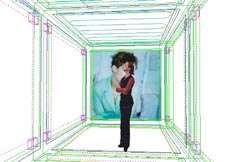 All inputs and outputs are hidden behind the panels so that the user experiences only the pure effect.
All inputs and outputs are hidden behind the panels so that the user experiences only the pure effect. 

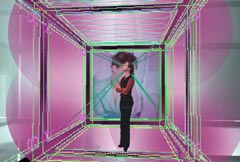 All adjustments are subtly made to fade into another, so that the user need not be bothered by the awareness of the system working and changing.
All adjustments are subtly made to fade into another, so that the user need not be bothered by the awareness of the system working and changing. 
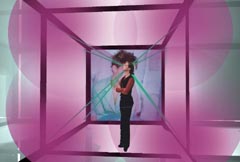 Zero|one adjusts the sound, lighting, display, communications, thermal radiation, and air-flow based on where you are, who you are, and what you are doing. This input is collected from the sensors and your zero|one profile; it is then processed through the zero|one ai program.
Zero|one adjusts the sound, lighting, display, communications, thermal radiation, and air-flow based on where you are, who you are, and what you are doing. This input is collected from the sensors and your zero|one profile; it is then processed through the zero|one ai program. 
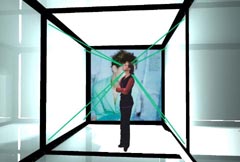 The sensors located at each corner of the wall panels measure a harmless electromagnetic signal which is transmitted through your body from the conductive floor panels. This allows the zero|one system to understand where you are in the room, as well as what position your body is in, based on the difference between you and the walls. Direct input can be given by hand movements and voice.
The sensors located at each corner of the wall panels measure a harmless electromagnetic signal which is transmitted through your body from the conductive floor panels. This allows the zero|one system to understand where you are in the room, as well as what position your body is in, based on the difference between you and the walls. Direct input can be given by hand movements and voice.
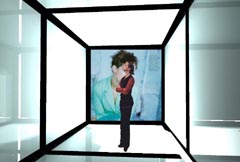 The user within the room experiences pure effect, not the systems which create it. The user becomes the object within the design.
The user within the room experiences pure effect, not the systems which create it. The user becomes the object within the design. 
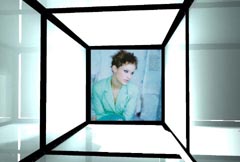 The design carves out an empty void, allowing the user and their desired effect to become the difference, the reality, within the design.
The design carves out an empty void, allowing the user and their desired effect to become the difference, the reality, within the design. 



